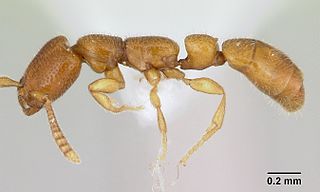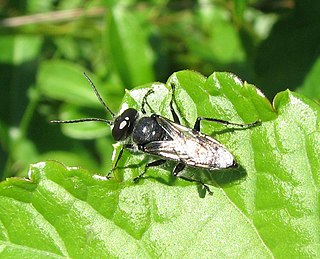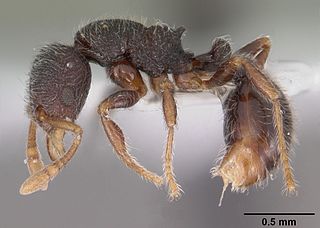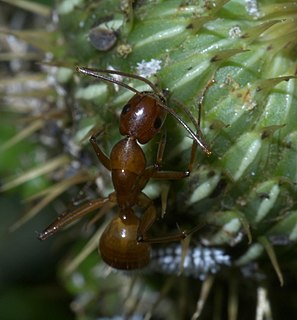
Aphaenogaster is a genus of myrmicine ants. About 200 species have been described, including 18 fossil species. They occur worldwide except in South America south of Colombia, Sub-Saharan Africa, and Antarctica.

Apomyrma stygia is a species of ant found in West Africa, first described in 1970 (1970). It is the only species in the genus Apomyrma, tribe Apomyrmini, and subfamily Apomyrminae. A newly described species, Opamyrma hungvuong, is apparently related to Apomyrma. It has been suggested the ant primarily lives in tropical forests, and apparently belongs to a guild of centipede feeding ants.
Discoelius is a palearctic genus of potter wasps with seven currently known species. It contains the following species:

Aenictus is a large army ant genus distributed in the Old World tropics and subtropics. It contains about 181 species, making it one of the larger ant genera of the world.

Aenictus ceylonicus is a species of reddish brown army ant found in Southern India, Sri Lanka, Southeast Asia and Australia. They are completely blind and around 3 mm in length. These ants are seen foraging underneath leaf litter in forests and well-vegetated areas, travelling in a trail of in three or more columns alongside each other, in parts of India. Their antennae, as in most species of Aenictus, have ten segments. The scape is long and extends above the head. The head is smooth and shiny. The mesosoma and the head region are dark brown, while the gaster is oval and lighter in colour, nearly translucent. The mesosoma is broad anteriorly and strongly compressed posteriorly. The petiole and the post petiole are large, conical and shining. They occur in rainforests and moist deciduous forests building temporary nests on the ground and in rotting logs.
Plazia is a genus of South American plants in the gerbera tribe within the daisy family.

Astata is a cosmopolitan genus of solitary predatory wasps in the subfamily Astatinae. They are known to prey on adults and nymphs of Pentatomidae. Astata is the largest genus in this subfamily, and is identified by features of its wing venation. The males of this genus and the related genus Dryudella have very large compound eyes that broadly meet at the top of the head.
The Journal of Hymenoptera Research is a peer-reviewed scientific journal covering systematics, taxonomy, and ecology of Hymenoptera. It was established in 1992, and transferred to publishing with Pensoft Publishers in 2011, under an open access system. According to the Journal Citation Reports, the journal has a 2013 impact factor of 0.966.

Probolomyrmex is a genus of ants in the subfamily Proceratiinae. The genus is distributed throughout the tropics and subtropics. The ants are very rare, and are rarely collected in the field, but they appear to be nesting in the leaf litter or in rotten wood. Little is known about their biology.

Lasiomyrma is a South-East Asian genus of ants in the subfamily Myrmicinae. The genus is mainly known from tropical rainforests in Sundaland.

Cladomyrma is a genus of ants in the subfamily Formicinae. The genus is restricted to the Malay Peninsula, Borneo and Sumatra. All known Cladomyrma species build their nests on live stems.
Aenictus gutianshanensis is a Chinese species of army ant in the genus Aenictus. The species is known only from a single colony. Little is known about its biology, but it is probably most closely related to A. vieti.

Acanthomyrmex humilis is a species of ant that belongs to the genus Acanthomyrmex. It was described by Eguchi, Bui and Yamane in 2008, and is abundant in Vietnam.
Pensoft Publishers are a publisher of scientific literature based in Sofia, Bulgaria. Pensoft was founded in 1994, by two academics: Lyubomir Penev and Sergei Golovatch. It has published nearly 1000 academic and professional books and currently publishes 24 peer-reviewed open access scientific journals including ZooKeys, PhytoKeys, Check List, Comparative Cytogenetics, Journal of Hymenoptera Research, Deutsche Entomologische Zeitschrift, and Zoosystematics and Evolution.
Josephine Christina Cardale worked as an entomologist for CSIRO from 1967 to 2001. She was a collection manager of Hymenoptera at the Australian National Insect Collection.

Colobopsis explodens Laciny & Zettel 2018 is a species of ant which is found in Southeast Asia. It is noted for a rare combat mechanism of workers exploding in self-defense, smothering the enemy with toxic and often deadly secretion.

Camponotus castaneus, the reddish carpenter ant, is a species of ant in the family Formicidae.

Camponotus chromaiodes, known generally as the ferruginous carpenter ant or red carpenter ant, is a species of ant in the family Formicidae.

Formica neogagates is a species of ant in the family Formicidae. Found throughout North America and Canada, introduced in Europe, France.

Loboscelidiinae is a subfamily of cuckoo wasps in the family Chrysididae. There are at least 2 genera and more than 40 described species in Loboscelidiinae.















